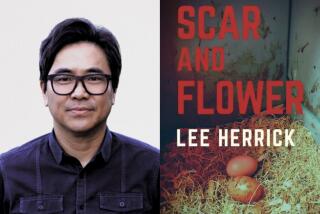Setting Times stories to music: From Replacements to Califone

My favorite album cover is the one for Miles Davis’ wonderful “Porgy and Bess.” I love so many things about the photo on the cover: the man’s white shirt, the woman’s knee, how it’s cropped to show just their midsections, how Davis (and surely it is he) is slouching in his chair.
But what I love most is the woman’s hand touching the trumpet. Is she handing it to him, or trying to take it away? I tend to think she wants him to put it down and just talk to her, for once. You could write a short story based on that one image. It’s so suggestive (in the literal sense, not the Miley Cyrus one).
So I was bowled over by the video for the soundtrack to Wednesday’s Great Read. It’s by the band Califone, and it’s like the “Porgy and Bess” cover come to life.
A man is playing a guitar. A woman in a wine-colored dress reaches out and touches his hair. Then she takes the guitar from his hands. He resists at first, and, finally, relents. She walks away with the guitar, down a street that looks like L.A.
But I won’t tell you everything, just say that the rest of the video involves an act of anger, a small firecracker flaring briefly on the ground, and a kiss. All in dreamy slow motion and the violet light of a Southern California sunset. The video is a thing of beauty -- watch it.
Anyway, in these roundups of the week gone by, I’d like to offer the first paragraphs of each Great Read (or, as they’re known in print, Column One) -- maybe they’ll buy your eye and you can settle in for a good weekend read. And you’ll also get the songs that inspired me while editing the stories, or reading them later if my fellow editor Millie Quan ushered them through. A story-song combo!
#
Lessons from a doctor congressman’s first year
Rep. Raul Ruiz was settling in on another flight home to the Southern California desert when the flight crew put out an urgent call for passengers with medical expertise.
Ruiz hurried down the aisle to find an elderly man collapsed in his seat. The Democratic congressman, an emergency room physician before voters sent him to Washington, struggled to find a pulse on his unconscious patient, measured his blood sugar and readied a defibrillator.
The man, a diabetic, had normal glucose levels, but a companion warned that he had already suffered one stroke and was on a pacemaker. After reviving for a time, the man fainted again, and Ruiz recommended an emergency landing. By the time the American Airlines jet touched down in Raleigh, N.C., less than an hour later on that October day, the patient had been stabilized.
The portrait of the doctor-turned-lawmaker-turned-doctor might encapsulate Ruiz’s first year as a congressman. He arrived last January with one of the hottest stories of the freshman class: the political naif from just this side of nowhere who knocked off a seven-term incumbent. But his biggest splash came on a day flying away from the Capitol and practicing his old trade.
Living up to a promising biography is no small task in Washington, where newcomers often think they have the cure for what ails the government, only to face problems that appear terminal. The rookie Ruiz confronted the additional challenge of serving in the minority party in a House renowned for both partisanship and ineffectiveness.
And his most notable votes -- staking out the middle ground and defying the Democratic Party line on a pair of modifications to the Affordable Care Act -- weren’t going to make him a hero on the right or the left.
It’s no wonder that he focused much of his energy on a district that stretches from Hemet and Palm Springs to the Arizona border. His deepest emotional attachments remain there too.
#storysongs combo: “Heroes,” by David Bowie. This is probably my favorite song by Bowie (who turned 67 this week. Gasp.) Such yearning and quiet defiance and love.
#
Myanmar’s historic buildings imperiled by modern world
Over cappuccino at a crowded conference on real estate in one of the world’s last frontier markets, one investor turned to another and said breezily, “I’m here to get rich.”
They had paid more than $2,000 each to attend panels with titles like “Futurescape in Myanmar” and “Opportunities in Hotels and Resorts.” The seminar’s sponsors, which included a prominent local construction firm, handed out business cards and glossy brochures highlighting the shining new condos and shopping malls they hope to build.
Thant Myint-U stood out amid the suits. Dressed in sandals and a traditional sarong, the academic-turned-preservationist stepped to the lectern and asked the financiers and developers who had come to take advantage of Myanmar’s future to pause for a moment and consider the past.
Decades of self-imposed isolation and international sanctions against this longtime pariah state have left Myanmar in limbo, with three-quarters of the population still without electricity. But the lack of Western investment had an unexpected benefit for preservationists: Much of Yangon was left an architectural time capsule.
Thant Myint-U flashed through a PowerPoint presentation highlighting the scores of Victorian, Art Deco and neoclassical buildings that still line downtown Yangon’s noisy streets. These relics tell the story of Myanmar’s modern history, he said, of its decades under British colonial rule and fight for independence.
Now, as Myanmar’s former military leaders open up to countries that once banned investment here, such buildings are at risk.
Hundreds of colonial-era structures have been destroyed in recent years to make way for modern ones like the Centrepoint tower. Completed last year, the glassy 25-story skyscraper looms over a historic block that includes the dilapidated 100-year-old Supreme Court building and City Hall, which, with its white paint and intricately tiered roof, draws easy comparisons to a wedding cake.
The condition of many older buildings makes them targets for tear-down. The Corinthian columns have crumbled at the building that once housed Sofaer’s department store, and mildew has sprouted from its domed tower. Other once-grand buildings have been subdivided into crowded apartments, with residents stringing laundry across staircases.
Thant Myint-U, 47, is worried that Yangon could lose even more of its cultural heritage and become just another Southeast Asian metropolis crowded with soulless office buildings and boxy apartment towers.
#storysongs combo: “Past in Present,” Feist. Love the clap-along chorus.
#
An atypical orchestra offers music for China’s masses
Two hours before showtime at Beijing’s prestigious National Center for the Performing Arts, China’s equivalent of the Met, performers with the American Hollywood Film Orchestra were having a vaudevillian moment.
It was the latest stop on a blitzkrieg winter tour of China for a somewhat motley but certainly merry group of American minstrels definitely not from Hollywood.
They schlep by bus, train and plane to more than a dozen cities from late December to mid-January, offering up crowd-pleasing medleys from movies such as “Titanic,” “Dances With Wolves,” “The Incredibles” and “The Godfather.” To save on travel expenses, the group doesn’t lug around large instruments such as drums, upright basses or even cellos; local promoters in each town provide them.
On this Saturday evening in Beijing, two cellists opened the cases of the loaner instruments and found that the bridge on one had come completely off. Nearby, percussionist Chris Nolin briefly had steam coming out of his ears.
“Nicest hall in China and they give me the crappiest drum kit!” he exclaimed, pointing at the pitted and sagging drum heads. Stagehands with walkie-talkies, an interpreter and the local promoter buzzed around the stage, trying to figure out what to do.
But as they say in Hollywood, the show must go on, and so it did. (Nolin got his new drum heads 20 minutes before the curtain went up for the show, called “Classic Oscar: The American Hollywood Film Orchestra New Year’s Audio-Visual Concert.”)
At 7:30 p.m., conductor Jason Altieri took to the podium, raised his baton and launched the group into Berlioz’s “Rakoczi March.” Its ostensible Oscar connection? Well, there was none, but the song was included in the 1966 French film “La Grande Vadrouille,” which, judging from the accompanying clips on a giant screen at the rear of the stage, was a slapstick comedy with lots of Nazis.
The orchestra’s grueling schedule — 5:30 a.m. wake-ups, 11 p.m. dinners, with travel, rehearsal and performances in between — attests to the popularity of Hollywood fare in China as well as the seemingly insatiable demand for Western orchestral music as the country invests heavily in new concert venues and classical music education.
#storysongs combo: “Movie Music Kills a Kiss,” by Califone.
#
A private club more about young blood than blue
Just before his 40th birthday, Todd Seligman got an invitation into a world where he was certain he didn’t belong.
“Why don’t you come down?” the woman on the other end of the line asked. “We’ll give you lunch and show you the club.”
The locale in question was the City Club, a members-only spot downtown. The kind of place with dark wood paneling on the walls, waiters who address you by name as they refill your coffee and men in suits. Seligman was a former pro BMX biker who produced action-sports videos and showed up to work most days in jeans and a Volcom hoodie.
“I was like, ‘private club?’ “ Seligman said, scrunching his upper lip toward his nostrils like he’d just smelled something rotten. “But then I was like well, whatever. Free lunch? OK.”
At first glance he saw the hints of old money he expected when he initially called to find out about booking a space at the club for his birthday. But then he noticed a few other things: its easy vibe and diversity. There were purse hooks at the bar, and not everyone was white and nearing retirement age.
He wanted to come back sometime and bring his wife.
But when he pitched the idea to Sian — a thick-framed-glasses-and-bright-red-lipstick-wearing urban farmer — she shot back: “You know I’m an Asian woman, right?”
The BMX biker and the urban farmer. The most unlikely members, they thought, and yet, a couple of years later, they spend three or four days a week at the club, shelling out $280 a month for a membership that doesn’t even include a gym.
They used to call them “gentlemen’s clubs,” places where the who’s who of (white male) Los Angeles rubbed pinstriped shoulders. Even today, two of the oldest private clubs in the city, the Jonathan Club and California Club, have a no-jeans policy. But in the 21st century, as the economy tanked and start-ups changed what wealth looks like, some in the old guard realized that they needed to change.
#storysongs combo: “I Prefer the Twentieth Century,” by the Lucksmiths. “I’m not typically one to rush to judgment/But I’m having difficulty dealing with adjustment/I suppose that I’ll get used to it eventually/But so far I prefer the Twentieth century.”
#
Mother’s killing drives daughter’s quest for answers
When Alison Galvani graduated from kindergarten in the summer of 1982, her mother took her to the musical “Annie” to celebrate. Then they went to Golden Gate Park for a picnic, spreading out a sleeping bag with white and yellow egrets on a green background. Alison played with her “Annie” doll.
Her mother, Nancy, had just filed for divorce, and she and Alison had moved into a residential hotel in San Francisco’s seedy Tenderloin. Alison’s father, Patrick, remained in the family’s Victorian in Pacific Heights, one of the city’s priciest neighborhoods.
Days after the picnic, fishermen found Nancy’s body floating in San Francisco Bay. She had been strangled and was wearing only underpants. Her killer had bound her ankles and stuffed her into a sleeping bag, tying it with rope and weighting it with a cinder block.
Alison was 5. She remembers being with her father after her mother disappeared and waiting for her return. She ran to the window every time she heard a car. She remembers the arrival of police officers. They swarmed the house.
She said she was shown a photograph of the sleeping bag that shrouded her mother’s body. It was the one she and her mother had used for the picnic, sprinkled with yellow and white egrets. It looked wet.
Alison said she remembers peering through a window and seeing her father handcuffed in the street and put into a police car.
Then her father returned home and took her to Pier 39 to ride the carousel. She said she felt relieved, and told him how much she loved him.
#storysongs combo: “Sadly Beautiful,” by the Replacements. Sometimes the songs for the stories really move me. This is one of them. I could imagine Alison’s mom singing it to her today.
#
If you have ideas for story-song pairings of your own, tweet the title and artist to @karihow or @LATgreatreads with the hashtag #storysongs.
More to Read
Start your day right
Sign up for Essential California for news, features and recommendations from the L.A. Times and beyond in your inbox six days a week.
You may occasionally receive promotional content from the Los Angeles Times.




